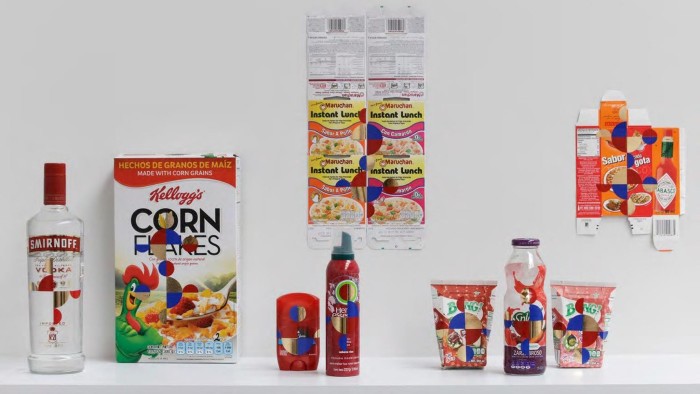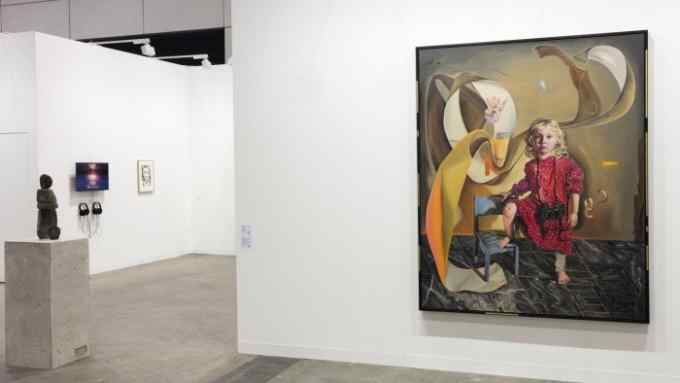Gabriel Orozco on art and branding

Simply sign up to the Life & Arts myFT Digest -- delivered directly to your inbox.
Mexican artist Gabriel Orozco may not be stealing as much of the limelight as some of the other artists in Hong Kong this week — Jeff Koons hosted an impromptu press conference in the Art Basel Hong Kong fair on Tuesday — but his work is making its presence felt.
On Wednesday, the city’s long-awaited M+ museum, due to be completed at the end of 2019, announced that among its latest acquisitions is a large part of Orozco’s “Untitled (OROXXO)” project (2017), a collection of 76 re-designed, empty packages of food, drink and other goods bought from OXXO, a ubiquitous convenience shop in Mexico. Meanwhile, in Art Basel Hong Kong, Orozco’s Mexican gallery Kurimanzutto has dedicated its booth to the artist’s latest works, particularly the limestone sculptures begun in 2017 (works range between $250,000 and $900,000).
Originally made for an interactive show at Kurimanzutto last year, Orozco’s corner shop project has more of an Asian influence than its title suggests. The nomadic artist has a home in Tokyo (as well as in Mexico City, New York, Paris and, most recently, Bali) and it was here that the idea came to him. “I don’t speak Japanese so found it a very abstract encounter to recognise products in a corner store just by their branding,” he says. “You get a pretty good idea of the landscape of a country from its convenience stores.” Doryun Chong, deputy director and chief curator of M+, believes this has resonance throughout Asia, particularly in Hong Kong, “where there’s a 7-Eleven on every corner.”
Part of Orozco’s process was to put his own trademark motif — a circle divided into colour-filled halves or quarters — on to the packages. He’s not afraid to call this blue, red, white and gold design a “logo” and to explore the commercial and commoditising potential of art, high and low. When we meet, he proudly shows me stickers he has customised for his mobile phone case and tells me that he hands them out to friends. This seems part of the package from an artist whose own market began by exchanging works with other artists in his close-knit circle, and who has long provided support to younger artists as well as to Kurimanzutto — gallery cofounder Mónica Manzutto says she couldn’t have started (in the 1990s) without him. The M+ acquisition was made in part “through the artist’s generous donation”, according to a statement from the museum.
“Untitled (OROXXO)” didn’t originally have a name, but the play on words appeals to the artist and its nickname has stuck. Indeed, Orozco likes words, numbers and game theory. He has long been fascinated by chess, particularly the knight move, and the machinations of the art market intrigue him. In its initial iteration, his convenience store was fully functioning, with all its goods for sale, each going for 50 per cent less than the item that had sold just before — a mathematical reversal of the art market’s norm, where with editioned works, prices often go up as the editions sell and there are fewer in circulation. His show opened at the same time as the Zona Maco art fair in Mexico City. “Money was an important part of the project as it was put together in the context of the art market. I tried to collapse the two worlds a bit,” Orozco says.
His solid, minimal new sculptures at Art Basel Hong Kong couldn’t seem more different, yet they are imbued with Orozco’s ongoing obsessions. Again, he was inspired by Asia. He went to Bali in 2010, initially for a matter of months, to learn limestone carving from its locally trained practitioners. He became attached to the place (his son is at school there) and to the carving process, not least because the soft stone was also used in Mayan building. He has learnt to do the carving himself but has a professional alongside him, “who is much faster than me,” he says.
The blocks they work with start out as six-sided cubes — the series title is Dés, the French word for dice — and into them he carves his circles and parts of circles, sometimes very deep, sometimes just scratching the surface. “Sculpture is very different, because you are taking something away, so you can’t make a mistake. Sometimes I leave it a day to be certain of what I’m going to do,” he says. Out of the forms emerge flowers, fruit, faces, a skull, a game of noughts and crosses — the OXXO shelves don’t seem so far away.
To March 31, artbasel.com; westkowloon.hk

Comments